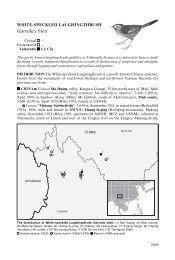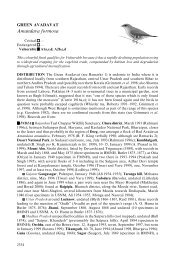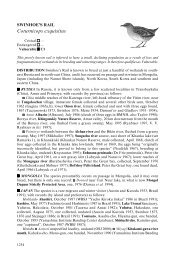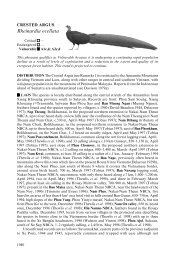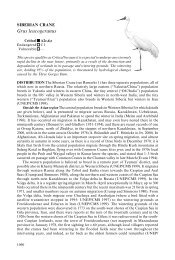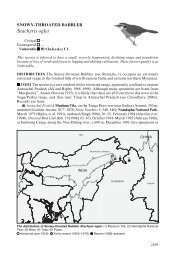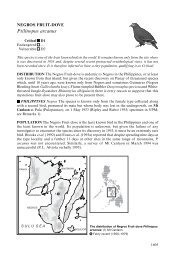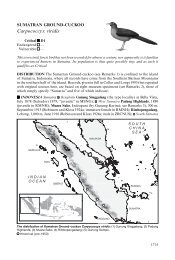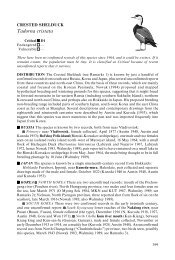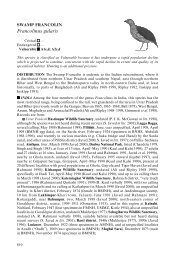Myophonus blighi - BirdBase
Myophonus blighi - BirdBase
Myophonus blighi - BirdBase
You also want an ePaper? Increase the reach of your titles
YUMPU automatically turns print PDFs into web optimized ePapers that Google loves.
SRI LANKA WHISTLING-THRUSH<br />
<strong>Myophonus</strong> <strong>blighi</strong><br />
Critical —<br />
Endangered B1+2a,b,c,d,e; C2a<br />
Vulnerable C1<br />
This species has a very small, severely fragmented, declining population and range as a result of<br />
degradation and destruction of upland forest. Pollution of streams by agricultural chemicals is<br />
an additional threat. It therefore qualifies as Endangered.<br />
DISTRIBUTION The Sri Lanka Whistling-thrush is confined to a few suitable sites in the<br />
montane forests (above c.900 m) of the hill zone, in the mountains of central Sri Lanka. Its<br />
forest habitat is now highly fragmented within its small range (see Threats), and was recently<br />
estimated to total only c.700 km 2 within a range of only c.1,700 km 2 (Warakagoda 1997).<br />
From the evidence below, the species has been recorded at 10 sites since 1990. Records<br />
(arranged approximately from north to south) are as follows:<br />
■ SRI LANKA Gammaduwa, at “Forest Hill”, February 1941 (clutch of two eggs in BMNH),<br />
at “Yammadua” (presumably Gammaduwa), 900 m, August 1938 (juvenile male in BMNH);<br />
Knuckles range, Laggala Gap, undated (Ceylon Bird Club News September 1997), one, 1991–<br />
1996 (IUCN/WCMC/FAO 1997); Midlands Estate, 1,200 m, female, March 1997 (Ceylon<br />
Bird Club News March 1997); Bambrakelly (Bambarakelle, Bambarella), east of Madulkele,<br />
undated (Ceylon Bird Club News September 1997); Punduloya, April 1889, May 1890, April<br />
1895 (three clutches of 1–2 eggs in BMNH), May 1895 (female in BMNH); Nuwara Eliya,<br />
1,800 m, June 1870 (Holdsworth 1872, juvenile female in AMNH), July 1870 (Legge 1880),<br />
March 1886 (two specimens in BMNH), April–May 1896 (clutches of one and two eggs in<br />
BMNH), April 1908 (clutch of one egg in BMNH), below the lake, December 1973 (Ceylon<br />
Bird Club News December 1973), at the golf course, December 1974 (Ceylon Bird Club News<br />
December 1974), April 1984 (Ceylon Bird Club News April 1984), at the lake, January 1988<br />
(Ceylon Bird Club News January 1988); Sitaeliya, presumably in Kandapola Sitaeliya Forest<br />
Reserve, December 1981 (Ceylon Bird Club News December 1981), at Kandapola Forest<br />
Reserve-Bambaraeliya Oya dam, March 1982 (Ceylon Bird Club News March 1982), one,<br />
March 1997 (Ceylon Bird Club News March 1997); Kabaragala, at “Kabaragala-<br />
Nawalapitiya”, 900–1,150 m, undated (Legge 1880), undated (Ceylon Bird Club News<br />
September 1997); Hakgala, at “Hakgala road”, 1875 (Legge 1880), many records until at<br />
least January 1998 (Ceylon Bird Club News February 1993, many observers in litt. 1998),<br />
including at Hakgala waterfall, October 1981 (Ceylon Bird Club News October 1981) and<br />
one seen and one heard, December 1990 (Ceylon Bird Club News December 1990), by the<br />
Hakgala–Nuwara Eliya road, 1982 (Ceylon Bird Club News March 1982, April 1982), in<br />
Hakgala Strict Nature Reserve, May–October 1995 (Ranawana and Bambaradeniya 1998),<br />
and in Hakgala Ravine, January 1998 (P. J. Hines in litt. 1998); Pedro, one, 1991–1996 (IUCN/<br />
WCMC/FAO 1997); Elk plains, Nuwara Eliya, juvenile female collected, April 1923, juvenile<br />
male collected, May 1927 (Whistler 1944); Welimada-Surrey, February 1981 (Ceylon Bird Club<br />
News February 1981); Osborne estate, Dickoya, April 1924 (clutch of one egg in BMNH);<br />
Dickoya (Dichroga), c.915 m, April 1919 (clutch of two eggs in BMNH); Pattipola-Ambawela,<br />
two, 1991–1996 (IUCN/WCMC/FAO 1997); Maskeliya, at “Maskeli Oya-Maskeliya”, 1,150 m,<br />
December 1876 and January 1877 (Legge 1880), below Meriacotta Peak, undated (Lewis 1898);<br />
Horton Plains, undated (Legge 1880), at “Arrenga Pool”, December 1981 (Ceylon Bird Club<br />
News December 1981) and undated (Ceylon Bird Club News March 1982), December 1982<br />
1989
Threatened birds of Asia<br />
SRI LANKA<br />
1<br />
4<br />
2 3<br />
8<br />
25<br />
5<br />
6 7<br />
9<br />
13 14 11 12<br />
16<br />
15<br />
20 18<br />
19 17<br />
22<br />
23<br />
21<br />
26<br />
24<br />
10<br />
I N D I A N O C E A N<br />
1990
<strong>Myophonus</strong> <strong>blighi</strong><br />
(Ceylon Bird Club News December 1982), up to five in the area 1999–2000 (D. Warakagoda<br />
verbally 2000), also at the Dayagama Road, January 1985, February 1992, December 1992,<br />
January 1993 (Ceylon Bird Club News January 1985, February 1992, December 1992, January<br />
1993), and at the Kirigalpotta road, January 1993, February 1993, August 1993, November<br />
1993, March 1995, February 1996, November 1997, December 1998 (Ceylon Bird Club News<br />
January 1993, February 1993, August 1993, November 1993, March 1995, February 1996,<br />
November 1997, December 1998); Ohiya, 1,800 m, male collected, April 1927 (Whistler 1944);<br />
Adam’s Peak, Central Province side, three sightings, undated (Lewis 1898); Bogawantalawa,<br />
April 1911 (female in AMNH, clutch of two eggs in BMNH); Lemastota Oya-Pitaratmale,<br />
Haputale, 1,275 m, 1868 (Legge 1880), at “Haputale West”, July 1931 (specimen NMGC);<br />
Tangamalai Sanctuary, undated (Ranasinghe 1982); Peak Wilderness, now Peak Wilderness<br />
Sanctuary, undated (Legge 1880), one heard, December 1990 (Ceylon Bird Club News December<br />
1990), one, 1991–1996 (IUCN/WCMC/FAO 1997); Poonagalla (Veryan-Poonagala), September<br />
1970 (Ceylon Bird Club News September 1970); Gilimale forest, undated (Lewis 1898); Morahela<br />
forest, above 1,200 m, two, undated (Lewis 1898); Dandukelewa (not mapped), breeding March<br />
1922 (Tunnard 1922); Meda-Maha Nuwara (untraced), July 1966, in a cardamom plantation<br />
(three specimens in FMNH); Tabrobanian (untraced), breeding, 1887 (Tunnard 1922).<br />
POPULATION The Sri Lanka Whistling-thrush has always been considered rare. Legge<br />
(1880) referred to it as “one of our rarest hill-birds” but noted that it might be commoner<br />
than it appears, as it is easily overlooked, a view supported by others (e.g. Warakagoda<br />
1997, G. de Silva Wijeyeratne in litt. 1999). Whistler (1944) thought it “moderately rare”,<br />
while Henry (1955) considered it “scarce”. Phillips (1978) described it as occurring “in small<br />
numbers” in its habitat. There are few recent published records concerning its present<br />
abundance but Kotagama and Fernando (1994) considered it “very rare” and Wijesinghe<br />
(1994) “scarce”, and there is strong evidence that its population must be both small and<br />
declining (Hoffmann 1984, R. Perera in litt. 1997; see Threats). During a major survey of<br />
over 200 forest sites in Sri Lanka in 1991–1996, this species was recorded in only four forests<br />
(IUCN/WCMC/FAO 1997), although this very low figure is in part a reflection of the species’s<br />
very limited range. Given its very small range and the reduction in the area of its forest<br />
habitat, it is unlikely that it currently numbers more than a few thousand individuals.<br />
ECOLOGY Habitat This is a secretive, ground-dwelling bird, usually only emerging into the<br />
open at dawn and dusk (Warakagoda 1997). It is confined to relatively undisturbed dense<br />
mountain forests in the central uplands of Sri Lanka above c.900 m (Legge 1880, Phillips<br />
1978, Hoffmann 1984), although it is now found mainly between about 1,200 and 2,100 m<br />
(Warakagoda 1997). Henry (1955) described its habitat as “densely wooded, ferny ravines<br />
and gorges, especially those that have a rapid torrent running through them, for it is seldom<br />
seen far from a stream”. This requirement for streams is noted by many other authors (e.g.<br />
Legge 1880, Lewis 1898, Wait 1931, etc.), although birds have sometimes been seen feeding<br />
away from water during the daytime (Warakagoda 1997). Most records are from undisturbed<br />
areas, but a pair has been found occupying a short stretch of stream running parallel to a<br />
much frequented highway (T. W. Hoffmann verbally 1997).<br />
The distribution of Sri Lanka Whistling-thrush <strong>Myophonus</strong> <strong>blighi</strong> (map opposite): (1) Gammaduwa;<br />
(2) Knuckles; (3) Midlands Estate; (4) Bambrakelly; (5) Punduloya; (6) Nuwara Eliya; (7) Kandapola Sitaeliya<br />
Forest Reserve; (8) Kabaragala; (9) Hakgala; (10) Pedro; (11) Elk plains; (12) Welimada; (13) Osborne estate;<br />
(14) Dickoya; (15) Pattipola-Ambawela; (16) Maskeliya; (17) Horton Plains; (18) Ohiya; (19) Adam’s Peak;<br />
(20) Bogawantalawa; (21) Haputale; (22) Tangamalai Sanctuary; (23) Peak Wilderness Sanctuary;<br />
(24) Poonagalla; (25) Gilimale; (26) Morahela.<br />
Historical (pre-1950) Fairly recent (1950–1979) Recent (1980–present) Undated<br />
1991
Threatened birds of Asia<br />
Food Insects are reported to be the main food of this species (Legge 1880, Henry 1955),<br />
but snails are also considered an important part of its diet (Delacour 1924a). It sometimes<br />
feeds on small reptiles and amphibians: the bones of a tree-frog, probably Polypedates, were<br />
found in a stomach (Legge 1880), and it has been observed eating small frogs and geckos<br />
(Henry 1955), and lizards (either Calotes or Ceratophora) (Warakagoda 1997).<br />
Breeding Pairs maintain territories throughout the year, although communal roosts of up<br />
to four males have been observed where territories adjoin (Warakagoda 1997). It has been<br />
reported to breed only from January to May, and not to have a second breeding season after<br />
the south-east monsoon (Tunnard 1922, Henry 1955), yet it has also been found nesting in<br />
September (Wait 1931, Whistler 1944). The nest is a large but compact, solid structure of moss<br />
and fern roots, lined with grass and placed on a ledge of rock by the side of a waterfall or a<br />
rapid (Tunnard 1922, Wait 1931, Henry 1955). One nest was found on a rock ledge 2 m above<br />
a rocky stream (at 900 m) (BMNH egg data). It also sometimes nests in a tree-fork or on a<br />
stump (Henry 1955). The full clutch appears to be two (Henry 1955; contra Tunnard 1922).<br />
THREATS The Sri Lanka Whistling-thrush is one of (now) seven threatened members of<br />
the suite of 23 bird species that are entirely restricted to the “Sri Lanka Endemic Bird Area”,<br />
threats and conservation measures in which are profiled by Stattersfield et al. (1998).<br />
Habitat loss The main threat to this rare species is the clearance of its forest habitat<br />
(Hoffmann 1984, 1998); a general survey of forest loss in Sri Lanka is made in the equivalent<br />
section under Red-faced Malkoha Phaenicophaeus pyrrhocephalus. The main causes of forest<br />
loss and degradation within the range of this species have been the conversion of forest to<br />
timber plantations (Hoffmann 1984), firewood collection around Nuwara Eliya, Maskeliya<br />
and the Bogowantaalaw areas (T. W. Hoffmann verbally 1997, D. Warakagoda in litt. 1999),<br />
the clearance of land for agricultural development (R. L. Fleming Jr. 1977), and gem pitmining<br />
(D. Warakagoda in litt. 1999). Another concern is that forest die-back in the montane<br />
region is affecting the habitat of this species (Kotagama 1994). Preliminary and sporadic<br />
studies indicate that air pollution, causing acid clouds, rain and mist, mainly during the<br />
south-west monsoon, could be responsible (Hoffmann 1997).<br />
Pesticides This species may be threatened by agrochemical pollution of streams within its<br />
range (R. Perera in litt. 1997). The development of numerous vegetable farms around Nuwara<br />
Eliya and throughout upland areas such as Horton Plains is producing insecticide run-off<br />
into the streams, almost certainly harming stream-dependent birds such as the Sri Lanka<br />
Whistling-thrush, even if the forest areas around about them remain undisturbed (R. L.<br />
Fleming Jr. 1977).<br />
MEASURES TAKEN Legislation, habitat protection, research A brief review is made in the<br />
equivalent section under Red-faced Malkoha.<br />
Protected areas The species occurs in several national parks and forest reserves, including<br />
Peak Wilderness Sanctuary and Hakgala Strict Nature Reserve (see Distribution).<br />
MEASURES PROPOSED Habitat protection, protected areas A brief review is made in the<br />
equivalent section under Red-faced Malkoha.<br />
Research Given that this species may have been under-recorded (see Population), a census<br />
of potentially suitable riverine sites is recommended in order to improve understanding of its<br />
status, with fieldwork carried out at dawn and dusk when birds are most active and vocal<br />
(see Warakagoda 1997). A study of the effects of pesticide pollution on this (and other)<br />
riverine species in the mountains of Sri Lanka is also important. Despite the wealth of data<br />
generated by the National Conservation Review in 1991–1996, much more detailed and wideranging<br />
surveys will be required to plan and monitor the management of individual<br />
conservation forests once they are established (IUCN/WCMC/FAO 1997).<br />
1992



